Exploring the Impact of Music on Motor Skills and Coordination

Music has always been a powerful force that moves us, both emotionally and physically. But did you know that music can also have a profound impact on our motor skills and coordination? It’s true! The rhythmic patterns and melodies in music can stimulate our brains and bodies in ways that enhance our ability to move and coordinate.
When we listen to music, our brains automatically sync up with the beat and rhythm. This synchronization triggers a series of neural connections that activate various areas responsible for motor control. As a result, our movements become more fluid and synchronized with the music. Imagine dancing to a catchy tune – your body effortlessly glides and sways to the rhythm, almost as if it’s being guided by an invisible force. This phenomenon showcases the power of music to influence our motor skills.
Furthermore, playing a musical instrument takes this impact to a whole new level. Learning to play an instrument requires precise finger movements, hand-eye coordination, and fine motor skills. As musicians practice, they develop dexterity and agility in their hands and fingers, which can transfer to improved motor skills in other areas of life. Research has shown that children who learn to play instruments tend to have better motor skills and coordination compared to their non-musical peers.
But how exactly does music improve our coordination? One analogy that can help us understand this is comparing music to a conductor leading an orchestra. The conductor guides each musician to play their part at the right tempo and rhythm, ensuring a harmonious performance. Similarly, when we listen to music, it acts as our internal conductor, guiding our movements and helping us maintain a steady pace. This synchronization between music and movement creates a seamless connection between our minds and bodies, resulting in improved coordination.
The impact of music on motor skills and coordination is remarkable. Whether we’re dancing to our favorite tunes or playing an instrument, music has the power to enhance our movements and make them more fluid and coordinated. So the next time you find yourself tapping your foot to a catchy beat, remember that your brain and body are engaging in a beautiful dance orchestrated by the power of music.
Scientific Study Reveals: How Music Enhances Motor Skills and Coordination
Did you know that music can do more than just entertain our ears? A fascinating scientific study has recently revealed the incredible benefits of music when it comes to enhancing motor skills and coordination. It turns out that jamming to your favorite tunes not only uplifts your mood but also has a positive impact on your physical abilities.
So, how does music work its magic on our motor skills? Let’s dive into the details. When we listen to music, our brains become captivated by the rhythm, melody, and beat. This engagement triggers various areas of our brain, including those responsible for coordinating movement. As a result, our motor skills get a boost, and our coordination improves.
Imagine music as a personal trainer for your brain and body. Just like a skilled instructor guiding you through exercise routines, music assists in synchronizing your movements. Whether you’re tapping your foot or swaying your hips to the rhythm, these actions create a connection between auditory stimuli and physical response. It’s like a beautifully choreographed dance between your brain and muscles.
Furthermore, music acts as a motivational force. Have you ever noticed how energized you feel when your favorite song comes on? That’s because music triggers the release of dopamine, a neurotransmitter associated with pleasure and reward. This surge of dopamine not only lifts your spirits but also enhances your focus and determination, leading to improved motor skills.
The impact of music on motor skills extends beyond mere enjoyment. Research has shown that individuals who engage in musical activities, such as playing an instrument or dancing, display enhanced coordination and dexterity. Children who receive early musical training often exhibit better motor skills development compared to their non-musical peers.
Unlocking the Rhythm: How Music Training Boosts Motor Abilities
Have you ever wondered how music can have such a profound impact on our motor abilities? It’s astonishing to think that something as intangible as sound can enhance our physical movements. But it’s true – music training has been found to unlock the rhythm within us, leading to improved motor skills and coordination.

When we engage in music training, whether it’s playing an instrument, singing, or even just tapping along to a beat, our brains are set into motion. The intricate patterns of rhythm, melody, and harmony activate various regions in our brain responsible for motor control. It’s like a dance between our auditory and motor systems, where they learn to synchronize and communicate with each other.

Think about it this way: imagine your brain as a conductor, and your body as the orchestra. With music training, the conductor becomes more skilled at guiding the different sections of the orchestra – your limbs, fingers, and vocal cords. They become attuned to the rhythmic cues and signals embedded in the music, allowing for smoother, more precise movements.
Furthermore, music training challenges our motor abilities in unique ways. Learning to play an instrument, for example, requires fine motor skills, hand-eye coordination, and finger dexterity. As we practice and refine these skills, neural connections are strengthened, and our motor abilities become more finely tuned. It’s like exercising specific muscle groups, but for the brain.
But the benefits of music training extend beyond the realm of instrumental proficiency. Studies have shown that children who receive music education demonstrate better motor skills, balance, and coordination compared to those who don’t. Even in adults, engaging in regular musical activities, such as dancing or drumming, can improve motor functions and reduce the risk of age-related decline.

So, whether you’re strumming a guitar, pounding on a drum set, or simply swaying to the rhythm of your favorite song, remember that you’re not only enjoying the music – you’re also unlocking the potential of your motor abilities. Through the power of music training, our brains and bodies become harmoniously entwined, creating a symphony of movement and expression.
From Beats to Body Movements: The Surprising Connection Between Music and Motor Skills

When we hear a catchy tune, it’s hard to resist tapping our feet or swaying along with the rhythm. But did you know that music goes beyond just making us move our bodies? There is a fascinating link between music and motor skills that scientists have been studying, revealing an intricate connection between these two seemingly unrelated domains.
Music has the power to ignite our senses and evoke emotional responses. It engages our brains in a unique way, activating various regions responsible for processing sound, movement, and coordination. As we listen to music, our brains start synchronizing with the beat, creating a natural urge to respond physically.
Numerous studies have shown that musical training can significantly enhance motor skills. Learning to play an instrument requires precise movements of the fingers, hands, and arms, which strengthens fine motor control. This improvement extends beyond the specific instrument being played; it also translates into enhanced dexterity and coordination in everyday activities.
But the influence of music on motor skills doesn’t stop there. Researchers have found that even passive listening to music can have a positive impact. When we sway, tap our feet, or dance to a song, our bodies naturally synchronize with the rhythm. This synchronization enhances our sense of timing and improves coordination between different body parts.
The connection between music and motor skills reaches further than physical movements. It also extends to cognitive abilities. Studies have demonstrated that individuals who engage with music exhibit enhanced problem-solving skills, better attention span, and improved memory. These cognitive benefits indirectly contribute to refined motor skills by enhancing overall brain function.
So, how can we harness the power of music to improve motor skills? Incorporating music-based activities into exercise routines, physical therapy sessions, or rehabilitation programs can be highly effective. Rhythmic exercises synchronized with music can promote better movement coordination and balance.
Striking a Chord: How Learning an Instrument Improves Physical Dexterity
Are you looking for a fun and engaging way to enhance your physical dexterity? Look no further than learning a musical instrument! Playing an instrument not only delights the senses but also provides a myriad of benefits that extend far beyond the realm of music. In this article, we’ll delve into how learning an instrument can improve your physical dexterity and unlock a world of possibilities.
When you pick up an instrument, whether it’s a guitar, piano, or drums, you embark on a journey that requires precise finger movements and coordinated hand-eye actions. As you begin practicing scales, chords, and melodies, your fingers become nimble and agile, like dancers effortlessly gliding across a stage. With each note, your brain sends signals to your muscles, refining their movements and boosting overall coordination.
Just like a workout for your body, playing an instrument engages various muscle groups, building strength and endurance. Your hands and fingers develop fine motor skills as they navigate the keys, strings, or drumsticks, while your arms and shoulders gain stability and control. The repetitive actions involved in playing an instrument train your muscles to move with precision and fluidity, enhancing your overall physical dexterity.
But the benefits don’t stop there. Learning an instrument is akin to performing mental gymnastics. As you read sheet music or memorize melodies, your brain undergoes a captivating workout. It’s like solving complex puzzles, activating multiple areas responsible for memory, attention, and problem-solving. This cognitive stimulation enhances your ability to process information swiftly and accurately, which translates to improved hand-brain coordination.

Moreover, playing an instrument can have a positive impact on your posture. Proper technique and body positioning are crucial for producing beautiful sounds. By maintaining a correct posture, you strengthen your core muscles, improve spinal alignment, and even alleviate tension and stress. As a result, you develop a more balanced and poised physique that positively influences your overall physical performance.




